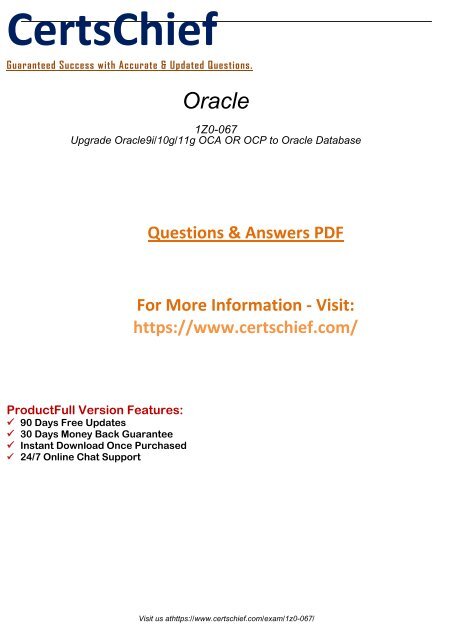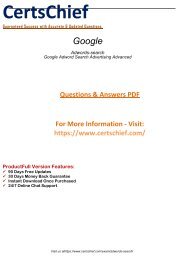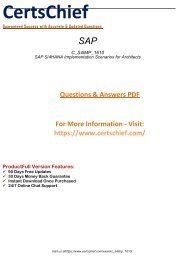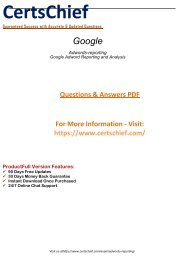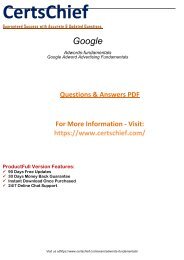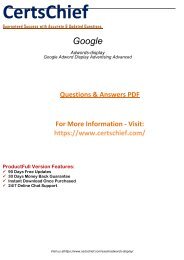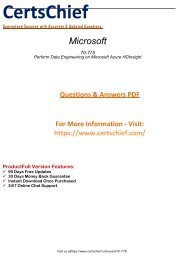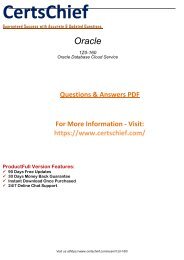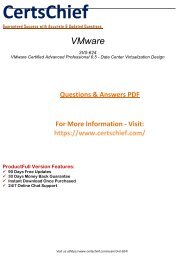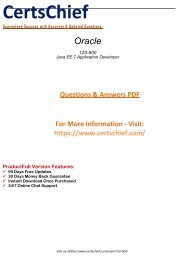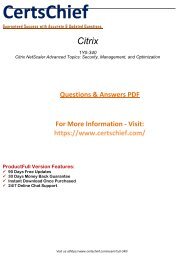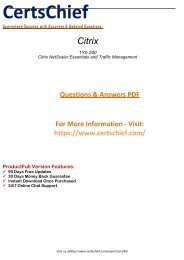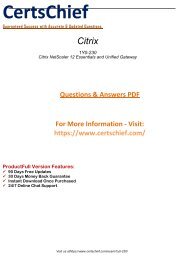1Z0-067
Study units and arrangement materials gave by us to 1Z0-067 Test are approved by the experts and industry specialists. You can without much of a stretch breeze through your accreditation test with our cerebrum dumps and PDF test questions. please use 20off2018 as discount voucher to avail 20% discount. For more information please visit here: https://www.certschief.com/exam/1Z0-067/
Study units and arrangement materials gave by us to 1Z0-067 Test are approved by the experts and industry specialists. You can without much of a stretch breeze through your accreditation test with our cerebrum dumps and PDF test questions. please use 20off2018 as discount voucher to avail 20% discount. For more information please visit here: https://www.certschief.com/exam/1Z0-067/
You also want an ePaper? Increase the reach of your titles
YUMPU automatically turns print PDFs into web optimized ePapers that Google loves.
CertsChief<br />
Guaranteed Success with Accurate & Updated Questions.<br />
Oracle<br />
<strong>1Z0</strong>-<strong>067</strong><br />
Upgrade Oracle9i/10g/11g OCA OR OCP to Oracle Database<br />
Questions & Answers PDF<br />
For More Information - Visit:<br />
https://www.certschief.com/<br />
ProductFull Version Features:<br />
90 Days Free Updates<br />
30 Days Money Back Guarantee<br />
Instant Download Once Purchased<br />
24/7 Online Chat Support<br />
Visit us athttps://www.certschief.com/exam/1z0-<strong>067</strong>/
Question: 1<br />
Which two statements are true about scheduling operations in a pluggable database (PDB)?<br />
A. Scheduler jobs for a PDB can be defined only at the container database (CDB) level.<br />
B. A job defined in a PDB runs only if that PDB is open.<br />
C. Scheduler attribute setting is performed only at the CDB level.<br />
D. Scheduler objects created by users can be exported or imported using Data Pump.<br />
E. Scheduler jobs for a PDB can be created only by common users.<br />
Answer: B,D<br />
Explanation:<br />
In general, all scheduler objects created by the user can be exported/imported into the PDB using data<br />
pump. Predefined scheduler objects will not get exported and that means that any changes made to<br />
these objects by the user will have to be made once again after the database has been imported into the<br />
pluggable database. However, this is how import/export works currently. A job defined in a PDB will run<br />
only if a PDB is open.<br />
Question: 2<br />
A complete database backup to media is taken for your database every day. Which three actions would<br />
you take to improve backup performance?<br />
A. Set the backup_tape_io_slaves parameter to true.<br />
B. Set the dbwr_io_slaves parameter to a nonzero value if synchronous I/O is in use.<br />
C. Configure large pool if not already done.<br />
D. Remove the rate parameter, if specified, in the allocate channel command.<br />
E. Always use RMAN compression for tape backups rather than the compression provided by media<br />
manager.<br />
F. Always use synchronous I/O for the database.<br />
Answer: B,C,D<br />
Explanation:<br />
Tuning RMAN Backup Performance: Procedure Many factors can affect backup performance. Often,<br />
finding the solution to a slow backup is a process of trial and error. To get the best performance for a<br />
backup, follow the suggested steps in this section: Step 1: Remove RATE Parameters from Configured<br />
and Allocated Channels Step 2: If You Use Synchronous Disk I/O, Set DBWR_IO_SLAVES Step 3: If You Fail<br />
to Allocate Shared Memory, Set LARGE_POOL_SIZE Step 4: Tune RMAN Tape Streaming Performance<br />
Bottlenecks Step 5: Query V$ Views to Identify Bottlenecks<br />
https://docs.oracle.com/database/121/BRADV/rcmtunin.htm#BRADV172<br />
Visit us athttps://www.certschief.com/exam/1z0-<strong>067</strong>/
Question: 3<br />
For which three pieces of information can you use the RMAN list command?<br />
A. stored scripts in the recovery catalog<br />
B. available archived redo log files<br />
C. backup sets and image copies that are obsolete<br />
D. backups of tablespaces<br />
E. backups that are marked obsolete according to the current retention policy<br />
Answer: A,B,D<br />
Explanation:<br />
About the LIST Command: The primary purpose of the LIST command is to list backup and copies. For<br />
example, you can list: -Backups and proxy copies of a database, tablespace, datafile, archived redo log,<br />
or control file -Backups that have expired -Backups restricted by time, path name, device type, tag, or<br />
recoverability -Archived redo log files and disk copies<br />
http://docs.oracle.com/cd/B28359_01/backup.111/b28270/rcmreprt.htm#BRADV89585<br />
Question: 4<br />
You notice performance degradation in your production Oracle 12c database. You want to know what<br />
caused this performance difference.<br />
Which method or feature should you use?<br />
A. Database Replay<br />
B. Automatic Database Diagnostic Monitor (ADDM) Compare Period report<br />
C. Active Session History (ASH) report<br />
D. SQL Performance Analyzer<br />
Answer: B<br />
Explanation:<br />
References: http://docs.oracle.com/cd/E24628_01/server.121/e17635/tdppt_degrade.htm<br />
Question: 5<br />
Which three statements are true about a job chain?<br />
A. It can contain a nested chain of jobs.<br />
B. It can be used to implement dependency-based scheduling.<br />
C. It cannot invoke the same program or nested chain in multiple steps in the chain.<br />
Visit us athttps://www.certschief.com/exam/1z0-<strong>067</strong>/
D. It cannot have more than one dependency.<br />
E. It can be executed using event-based or time-based schedules.<br />
Answer: A,B,E<br />
Explanation:<br />
Chains are the means by which you can implement dependency based scheduling, in which jobs are<br />
started depending on the outcomes of one or more previous jobs.<br />
DBMS_SCHEDULER.DEFINE_CHAIN_STEP<br />
DBMS_SCHEDULER.DEFINE_CHAIN_EVENT_STEP<br />
http://docs.oracle.com/cd/B28359_01/server.111/b28310/scheduse009.htm#ADMIN12<br />
Question: 6<br />
Because of logical corruption of data in a table, you want to recover the table from an RMAN backup to<br />
a specified point in time.<br />
Examine the steps to recover this table from an RMAN backup:<br />
1.Determine which backup contains the table that needs to be recovered.<br />
2.Issue the recover table RMAN command with an auxiliary destination defined and the point in time<br />
specified.<br />
3.Import the Data Pump export dump file into the auxiliary instance.<br />
4.Create a Data Pump export dump file that contains the recovered table on a target database.<br />
Identify the required steps in the correct order.<br />
A. 1, 4, 3<br />
B. 1, 2<br />
C. 1, 4, 3, 2<br />
D. 1, 2, 4<br />
Answer: D<br />
Explanation:<br />
Because according to oracle PDFs if you run restore table ... auxiliary a impede and rename can be<br />
included. So there is no reason to make the import manually if it can be already included in step 2.<br />
https://docs.oracle.com/database/121/BRADV/rcmresind.htm#BRADV689<br />
Question: 7<br />
Examine the command:<br />
SQL> RECOVER DATABASE USING BACKUP CONTROLFILE UNTIL CANCEL;<br />
In which two scenarios is this command required?<br />
A. The current online redo log file is missing.<br />
B. A data file belonging to a noncritical tablespace is missing.<br />
C. All the control files are missing.<br />
Visit us athttps://www.certschief.com/exam/1z0-<strong>067</strong>/
D. The database backup is older than the control file backup.<br />
E. All the data files are missing.<br />
Answer: A,C<br />
Explanation:<br />
http://searchoracle.techtarget.com/answer/Recover-database-using-backup-controlfile-until-cancel<br />
Question: 8<br />
Which two are prerequisites for setting up Flashback Data Archive?<br />
A. Fast Recovery Area should be defined.<br />
B. Undo retention guarantee should be enabled.<br />
C. Supplemental logging should be enabled.<br />
D. Automatic Undo Management should be enabled.<br />
E. All users using Flashback Data Archive should have unlimited quota on the Flashback Data Archive<br />
tablespace.<br />
F. The tablespace in which the Flashback Data Archive is created should have Automatic Segment Space<br />
Management (ASSM) enabled.<br />
Answer: D,F<br />
Explanation:<br />
http://www.dba-oracle.com/t_11g_new_enabling_fdba.htm There are a number of restrictions for<br />
flashback archives: The tablespaces used for a flashback archive must use local extent management and<br />
automatic segment space management. The database must use automatic undo management.<br />
Question: 9<br />
The environmental variable oracle_Base is set to /u01/app/oracle and oracle_home is set to<br />
/u01/app/oracle/product/12.1.0/db 1.<br />
You want to check the diagnostic files created as part of the Automatic Diagnostic Repository (ADR).<br />
Examine the initialization parameters set in your database.<br />
NAME TYPE VALUE<br />
-------------------------------------------- ------------------- ------------------------------------------------<br />
audit_file_deststring/u01/app/oracle/admin/eml2rep/adump<br />
background_dump_deststring<br />
core_dump_deststring<br />
db_create_file_deststring<br />
db_recovery_file_deststring/u01/app/oracle/fast_recovery_area<br />
diagnostic_deststring<br />
What is the location of the ADR base?<br />
Visit us athttps://www.certschief.com/exam/1z0-<strong>067</strong>/
A. It is set to/u01/app/oracle/product:/12.1.0/db_1/log.<br />
B. It is set to /u01/app/oracle/admin/en12.1.0/adump.<br />
C. It is set to /u01/app/oracle.<br />
D. It is set to /u01/app/oracle/flash_recovery_area.<br />
Answer: C<br />
Explanation:<br />
http://docs.oracle.com/cd/B28359_01/server.111/b28310/diag001.htm#ADMIN11008<br />
The Automatic Diagnostic Repository (ADR) is a directory structure that is stored outside of the<br />
database. It is therefore available for problem diagnosis when the database is down.<br />
The ADR root directory is known as ADR base. Its location is set by the DIAGNOSTIC_DEST initialization<br />
parameter. If this parameter is omitted or left null, the database sets DIAGNOSTIC_DEST upon startup as<br />
follows:<br />
If environment variable ORACLE_BASE is set, DIAGNOSTIC_DEST is set to the directory designated by<br />
ORACLE_BASE.<br />
If environment variable ORACLE_BASE is not set, DIAGNOSTIC_DEST is set to ORACLE_HOME/log.<br />
Question: 10<br />
You want to export the pluggable database (PDB) hr pdb1 from the multitenant container database<br />
(CDB)CDB1 and import it into the cdb2 CDB as the emp_pdb1 PDB.<br />
Examine the list of possible steps required to perform the task:<br />
1.Create a PDB named emp_pdb1.<br />
2.Export the hr_pdb1 PDB by using the full clause.<br />
3.Open the emp_pdb1 PDB.<br />
4.Mount the emp_pdb1 PDB.<br />
5.Synchronize the emp_pdb1 PDB in restricted mode.<br />
6.Copy the dump file to the Data Pump directory.<br />
7.Create a Data Pump directory in the emp_pdb1 PDB.<br />
8.Import data into emp_pdb1 with the full and remap clauses.<br />
9.Create the same tablespaces in emp_pdb1 as in hr_pdb1 for new local user objects.<br />
Identify the required steps in the correct order.<br />
A. 2, 1, 3, 7, 6, and 8<br />
B. 2, 1, 4, 5, 3, 7, 6, 9, and 8<br />
C. 2, 1, 3, 7, 6, 9, and 8<br />
D. 2, 1, 3, 5, 7, 6, and 8<br />
Answer: C<br />
Explanation:<br />
Because the step 2 says that you perfom an expdp with the full clause and you don’t need to create the<br />
tablespaces when you perform the impdp. FULL=yes will export tablespace definitions. So no need step<br />
9. https://docs.oracle.com/cd/B10501_01/server.920/a96652/ch01.htm<br />
Visit us athttps://www.certschief.com/exam/1z0-<strong>067</strong>/
Question: 11<br />
You wish to create jobs to satisfy these requirements:<br />
1. Automatically bulk load data from a flat file.<br />
2. Rebuild indexes on the SALES table after completion of the bulk load.<br />
How would you create these jobs?<br />
A. Create both jobs by using Scheduler raised events.<br />
B. Create both jobs using application raised events.<br />
C. Create one job to rebuild indexes using application raised events and another job to perform bulk<br />
load using Scheduler raised events.<br />
D. Create one job to rebuild indexes using Scheduler raised events and another job to perform bulk load<br />
by using events raised by the application.<br />
Answer: C<br />
Explanation:<br />
The bulk loader would be started in response to a file watcher scheduler event and the indexes would<br />
be rebuilt in response to an application event raised by the bulk loader.<br />
https://docs.oracle.com/cd/E18283_01/server.112/e17120/scheduse005.htm#CIABIEJA<br />
Your<br />
application can raise an event to notify the Scheduler to start a job. A job started in this way is referred<br />
to as an event-based job. The job can optionally retrieve the message content of the event.<br />
https://docs.oracle.com/cd/B28359_01/server.111/b28310/scheduse008.htm#CHDIAJEB<br />
Question: 12<br />
Your Oracle 12c multitenant container database (CDB) contains multiple pluggable databases (PDBs). In<br />
the PDB hr_pdb, the common user c##admin and the local user b_admin have only the connect<br />
privilege.<br />
You create a common role c##role1 with the create table and select any table privileges.<br />
You then execute the commands:<br />
SQL> GRANTc##role1 TOcMadmin CONTAINER=ALL;<br />
SQL>CONNsys/oracle@HR_PDB assysdba<br />
SQL> GRANTc##role1TO b_admin CONTAINER=CURRENT;<br />
Which two statements are true?<br />
A. C##admin can create and select any table, and grant the c##role1 role to users only in the root<br />
container.<br />
B. B_admin can create and select any table in both the root container and kr_pdb.<br />
C. c##admin can create and select any table in the root container and all the PDBs.<br />
D. B_admin can create and select any table only in hr_pdb.<br />
E. The grant c=»role1 to b_admin command returns an error because container should be set to ALL.<br />
Visit us athttps://www.certschief.com/exam/1z0-<strong>067</strong>/
Answer: C,D<br />
Question: 13<br />
Examine the commands executed in the root container of your multitenant container database (CDB)<br />
that has multiple pluggable databases (PDBs):<br />
SQL> CREATE USER c##a_admin IDENTIFIED BY orcl123;<br />
SQL> CREATE ROLE c##role1 CONTAINER=ALL;<br />
SQL> GRANT CREATE VIEW TO C##roleI CONTAINER=ALL;<br />
SQL> GRANT c##role1 TO c##a_admin CONTAINER=ALL;<br />
SQL> REVOKE c##role1 FROM c##a_admin;<br />
What is the result of the revoke command?<br />
A. It executes successfully and the c##role1 role is revoked from the c##a_admin user only in the root<br />
container.<br />
B. It fails and reports an error because the container=all clause is not used.<br />
C. It executes successfully and the c##rocl1 role is revoked from the c##a_admin user in the root<br />
database and all the PDBs.<br />
D. It fails and reports an error because the comtainer=current clause is not used.<br />
Answer: B<br />
Explanation:<br />
SQL> REVOKE c##role1 FROM c##a_admin; REVOKE c##role1 FROM c##a_admin * ERROR at line 1: ORA<br />
- 01951: ROLE ‘C##ROLE1’ not granted to ‘C##A_ADMIN’ SQL> REVOKE c##role1 FROM c##a_admin<br />
CONTAINER=ALL; Revoke succeeded. SQL> This CREATE USER c##a_admin IDENTIFIED BY orcl123; will<br />
create common user event container is not specified.<br />
Question: 14<br />
Examine the RMAN command:<br />
RMAN> CONFIGURE ENCRYPTION FOR DATABASE ON;<br />
RMAN> BACKUP DATABASE PLUS ARCHIVELOG;<br />
Which prerequisite must be met before accomplishing the backup?<br />
A. The password for the encryption must be set up.<br />
B. Oracle wallet for the encryption must be set up.<br />
C. All the tablespaces in the database must be encrypted.<br />
D. Oracle Database Vault must be enabled.<br />
Answer: B<br />
Visit us athttps://www.certschief.com/exam/1z0-<strong>067</strong>/
Explanation:<br />
Configuration encryption will used by Transparent encryption. For transparent encryption, you will need<br />
to create a wallet, and it must be open. Transparent encryption will then occur automatically after you<br />
have issued the CONFIGURE ENCRYPTION FOR DATABASE ON or CONFIGURE ENCRYPTION FOR<br />
TABLESPACE ON command.<br />
http://docs.oracle.com/cd/E25054_01/backup.1111/e10642/rcmbckad.htm#CEGEJABH<br />
CONFIGURE ENCRYPTION : You can use this command to persistently configure transparent encryption.<br />
You cannot persistently configure dual mode or password mode encryption. SET ENCRYPTION : You can<br />
use this command to configure dual mode or password mode encryption at the RMAN session level.<br />
Question: 15<br />
A database is running in archive log mode. The database contains locally managed tablespaces. Examine<br />
the RMAN command:<br />
RMAN> BACKUP<br />
AS COMPRESSED BACKUPSET<br />
SECTION SIZE 1024M<br />
DATABASE;<br />
Which statement is true about the execution of the command?<br />
A. The backup succeeds only if all the tablespaces are locally managed.<br />
B. The backup succeeds only if the RMAN default device for backup is set to disk.<br />
C. The backup fails because you cannot specify section size for a compressed backup.<br />
D. The backup succeeds and only the used blocks are backed up with a maximum backup piece size of<br />
1024 MB.<br />
Explanation:<br />
2018-04-01T21:58:00.47<br />
2018-04-01T21:58:00.48
RU<br />
JA<br />
X-NONE<br />
<br />
<br />
<br />
<br />
<br />
<br />
<br />
<br />
<br />
<br />
<br />
<br />
<br />
<br />
<br />
<br />
<br />
<br />
<br />
<br />
<br />
<br />
<br />
<br />
<br />
2018-04-01T21:58:00.51
<br />
<br />
<br />
<br />
<br />
<br />
<br />
<br />
<br />
<br />
<br />
<br />
<br />
<br />
<br />
<br />
<br />
<br />
<br />
<br />
<br />
<br />
<br />
<br />
<br />
<br />
<br />
UnhideWhenUsed="false" Name="Colorful Grid"/><br />
<br />
<br />
<br />
<br />
<br />
<br />
<br />
<br />
<br />
<br />
<br />
<br />
<br />
<br />
<br />
<br />
<br />
<br />
<br />
<br />
<br />
<br />
<br />
<br />
Visit us athttps://www.certschief.com/exam/1z0-<strong>067</strong>/
<br />
<br />
<br />
<br />
<br />
<br />
<br />
<br />
<br />
<br />
<br />
<br />
<br />
<br />
<br />
<br />
<br />
<br />
<br />
<br />
<br />
<br />
<br />
Visit us athttps://www.certschief.com/exam/1z0-<strong>067</strong>/
<br />
<br />
<br />
<br />
<br />
<br />
<br />
<br />
<br />
<br />
<br />
<br />
<br />
<br />
<br />
<br />
<br />
<br />
<br />
<br />
<br />
<br />
<br />
Visit us athttps://www.certschief.com/exam/1z0-<strong>067</strong>/
<br />
<br />
<br />
<br />
<br />
<br />
<br />
<br />
<br />
<br />
<br />
<br />
<br />
<br />
<br />
<br />
<br />
<br />
<br />
<br />
<br />
<br />
<br />
<br />
2018-04-01T21:58:00.52
* Style Definitions */<br />
table.MsoNormalTable<br />
{mso-style-name:"Table Normal";<br />
mso-tstyle-rowband-size:0;<br />
mso-tstyle-colband-size:0;<br />
mso-style-noshow:yes;<br />
mso-style-priority:99;<br />
mso-style-parent:"";<br />
mso-padding-alt:0cm 5.4pt 0cm 5.4pt;<br />
mso-para-margin-top:0cm;<br />
mso-para-margin-right:0cm;<br />
mso-para-margin-bottom:10.0pt;<br />
mso-para-margin-left:0cm;<br />
line-height:115%;<br />
mso-pagination:widow-orphan;<br />
font-size:11.0pt;<br />
font-family:Calibri;<br />
mso-ascii-font-family:Calibri;<br />
mso-ascii-theme-font:minor-latin;<br />
mso-hansi-font-family:Calibri;<br />
mso-hansi-theme-font:minor-latin;<br />
mso-ansi-language:RU;}<br />
<br />
<br />
2018-04-01T21:58:00.52<br />
COMPRESSED enables binary compression.<br />
RMAN compresses the data written into the backup set to reduce the overall size of the backup set. All<br />
backups that create backup sets can create compressed backup sets. Restoring compressed backup sets<br />
is no different from restoring uncompressed backup sets.<br />
RMAN applies a binary compression algorithm as it writes data to backup sets. This compression is<br />
similar to the compression provided by many media manager vendors. When backing up to a locally<br />
attached tape device, compression provided by the media management vendor is usually preferable to<br />
the binary compression provided by BACKUP AS COMPRESSED BACKUPSET.<br />
Therefore, use uncompressed backup sets and turn on the compression provided by the media<br />
management vendor when backing up to locally attached tape devices. You should not use RMAN binary<br />
compression andmedia manager compression together.<br />
Some CPU overhead is associated with compressing backup sets. If the target database is running at or<br />
near its maximum load, then you may find the overhead unacceptable. In most other circumstances,<br />
compressing backup sets saves enough disk space to be worth the CPU overhead.<br />
SECTION SIZE sizeSpec Specifies the size of each backup section produced during a data file backup.<br />
By setting this parameter, RMAN can create a multisection backup. In a multisection backup, RMAN<br />
creates a backup piece that contains one file section, which is a contiguous range of blocks in a file. All<br />
sections of a multisection backup are the same size. You can create a multisection backup for a data file,<br />
but not a data file copy.<br />
File sections enable RMAN to create multiple steps for the backup of a single large data file.<br />
RMAN channels can process each step independently and in parallel, with each channel producing one<br />
section of a multisection backup set.<br />
Visit us athttps://www.certschief.com/exam/1z0-<strong>067</strong>/
If you specify a section size that is larger than the size of the file, then RMAN does not use multisection<br />
backup for the file. If you specify a small section size that would produce more than 256 sections, then<br />
RMAN increases the section size to a value that results in exactly 256 sections.<br />
Depending on where you specify this parameter in the RMAN syntax, you can specify different section<br />
sizes for different files in the same backup job.<br />
Note: You cannot use SECTION SIZE with MAXPIECESIZE or with INCREMENTAL LEVEL 1.2018-04-<br />
01T21:58:00.52<br />
Visit us athttps://www.certschief.com/exam/1z0-<strong>067</strong>/
Powered by TCPDF (www.tcpdf.org)<br />
For More Information - Visit:<br />
https://www.certschief.com/<br />
20% Discount Coupon Code:<br />
20off2018<br />
Visit us athttps://www.certschief.com/exam/1z0-<strong>067</strong>/<br />
http://www.certschief.com/exam/0B0-104/<br />
Page | 1


